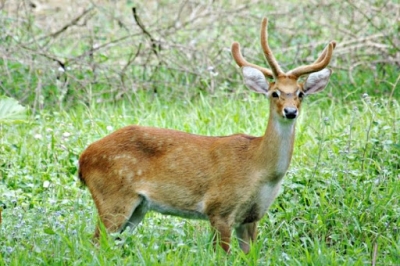
The sangai is an endemic and endangered subspecies of brow-antlered deer found only in Manipur, India. It is also the state animal of Manipur. The brow-antlered deer is a medium-sized deer, with uniquely distinctive antlers, measuring 100–110 cm. in length with extremely long brow tine, which form the main beam. The two tines form a continuous curve at right angles to the closely set pedicels. This signifies its name, brow-antlered deer, the forward protruding beam appears to come out from the eyebrow. The antlers of the opposite sides are unsymmetrical with respect to each other. The beams are unbranched initially whereas curvature increases as length increases and they get forked also. The sexes are moderately dimorphic in body size and weight. The height and weight of a fully grown stag may be approximately 115–125 cm at shoulder and 95 to 110 kg (210 to 230 lb) respectively. The height and weight of the female are shorter and less as compared to the male counterpart. The length of the body from the base to the ear up to the tail is about 145 to 155 cm in both sexes. The tail is short and rump patch is not pronounced.
Culturally, the sangai finds itself imbedded deep into the legends and folklore of the Manipuris. Based on a popular folk legend, the sangai is interpreted as the binding soul between humans and the nature. The slaying of the sangai, an unpardonable sin, is conceived as the rude breaking up of the cordial relationship between humans and the nature. When humans love and respect the sangai, it is respecting nature. In the sangai, therefore, humans find a way of expressing their love for the nature. Socially, the sangai is the symbol of a prized possession of the state.
It is believed that the name sangai (sa “animal” and ngai “in awaiting”) was coined from its peculiar posture and behaviour while running. By nature, the deer, particularly the males, even when running for its life stops occasionally and looks back as if he is waiting for someone and hence the name.
Picture Credit : Google



